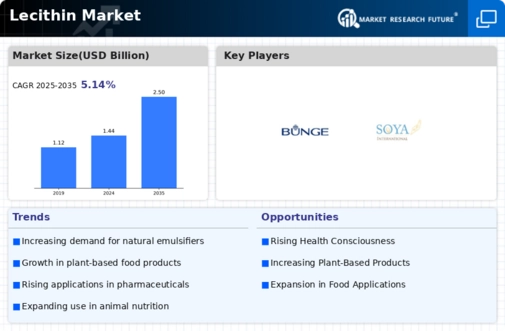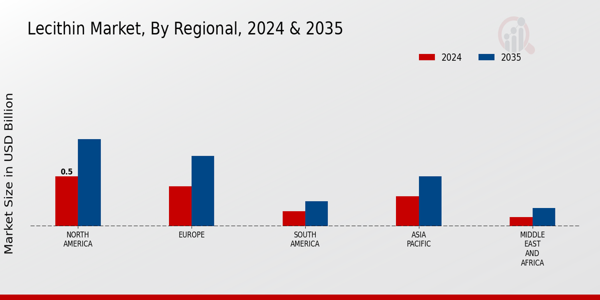Lecithin Size
Lecithin Market Growth Projections and Opportunities
The Lecithin market experiences the influence of various factors that collectively shape its growth and dynamics. One crucial driver is the rising demand for lecithin across diverse industries, including food and beverages, pharmaceuticals, and cosmetics. Lecithin, a natural emulsifier derived from soybeans, sunflowers, or eggs, finds extensive applications due to its emulsifying, stabilizing, and dispersing properties. In the food industry, lecithin is used to improve the texture and shelf life of products, while the pharmaceutical and cosmetic sectors utilize it for its role in formulation and texture enhancement.
Technological advancements and innovation contribute significantly to the Lecithin market. Continuous research in biotechnology and extraction methods has led to the development of high-quality lecithin with enhanced functionalities. This innovation expands the application scope of lecithin, making it a versatile ingredient in various products. The ability to tailor lecithin for specific industry needs and requirements further contributes to market growth, as manufacturers seek solutions that enhance the performance of their formulations. According to projections, the lecithin market business would expand at a compound annual growth rate (CAGR) of 4.95% from USD 20.5 billion in 2022 to USD 28.7 billion by 2030.
Globalization and international trade play a pivotal role in the Lecithin market. As companies expand their reach globally, there is an increasing demand for lecithin that complies with diverse regulatory standards and consumer preferences in different regions. Lecithin's status as a natural ingredient aligns well with the growing consumer preference for clean label products, driving its adoption in various markets worldwide. Additionally, the exchange of knowledge and technologies between regions fosters the development and utilization of lecithin in different cultural and industrial contexts.
The growing emphasis on health and wellness is another influential factor in the Lecithin market. As consumers become more health-conscious, there is a demand for products that offer nutritional benefits and contribute to overall well-being. Lecithin, known for its phospholipid content, is recognized for its potential positive impact on brain health and cholesterol metabolism. This health-related awareness contributes to the market's growth, as consumers seek products that align with their nutritional goals.
Environmental considerations and sustainability are emerging factors in the Lecithin market. With a growing focus on eco-friendly practices, companies are exploring sustainable sourcing methods for lecithin, such as non-GMO soybeans or sunflower lecithin. Consumers increasingly prefer products that are not only beneficial for their health but also produced with minimal impact on the environment. As a result, the adoption of sustainable and responsibly sourced lecithin aligns with broader trends in corporate social responsibility and environmentally conscious consumer choices.
Despite the positive trends, challenges exist in the Lecithin market. Price fluctuations of raw materials, such as soybeans, can impact the overall cost of lecithin production. Additionally, the need for clear labeling and transparency in the supply chain poses challenges for companies, especially those sourcing lecithin from genetically modified organisms (GMOs). Addressing these challenges requires strategic planning and continuous efforts to ensure a stable and reliable supply chain.







Leave a Comment